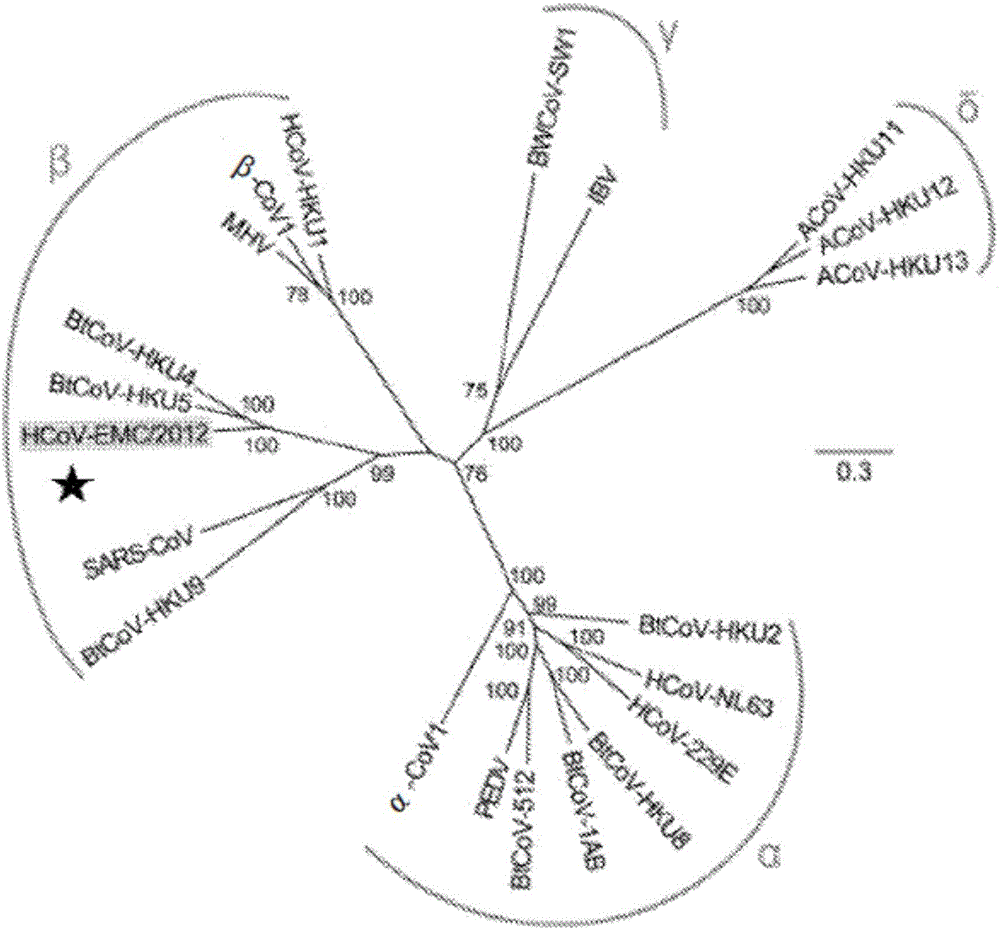MERS-CoV vaccine
A technology of immunogenicity and composition, applied in the vaccine field of Middle East Respiratory Syndrome Coronavirus, capable of solving limited and other problems
- Summary
- Abstract
- Description
- Claims
- Application Information
AI Technical Summary
Problems solved by technology
Method used
Image
Examples
Embodiment 1
[0179] MERS-CoV shared spike antigen
[0180] As described elsewhere in this article, multiple strains of MERS-CoV include image 3 It is shown that a common spike antigen is present and generated to account for the differences between these multiple MERS-CoV strains. Therefore, the MERS-CoV shared spike antigen is derived from image 3 The corresponding spike antigens of the viruses listed in. Based on the spike antigen for germline analysis and relative to its component spike antigen ( image 3 , The mark "MERS-HCoV-shared" means MERS-CoV shared spike antigen) Place the MERS-CoV shared spike antigen. The MERS-CoV shared spike antigen also contains the N-terminal immunoglobulin E (IgE) leader sequence. The nucleic acid and amino acid sequences containing the MERS-CoV shared spike antigen are shown in Figure 8A with 8B in. in Figure 8A In, the underline indicates the nucleotide encoding the IgE leader sequence. in Figure 8B In the middle, the underline indicates the IgE lea...
Embodiment 2
[0184] MERS-CoV shared spike antigen lacking cytoplasmic domain
[0185] The spike antigen from the coronavirus is a type 1 membrane glycoprotein, which has a transmembrane domain, which in turn defines the cytoplasmic and non-cytoplasmic domains of the spike antigen. In order to determine the location of the cytoplasmic domain in the MERS-CoV spike antigen, web-based software was used to predict the location of the domain in various MERS-CoV spike antigens. Specifically, the web-based software Phobius and InterProScan were used in this analysis. Representative results from Phobius and InterProScan analysis are shown in Figure 5 with 6 in.
[0186] Analysis of this domain of the MERS-CoV spike antigen generates a second MERS-CoV common spike antigen, which lacks a cytoplasmic domain. Specifically, the nucleic acid sequence encoding the MERS-CoV shared spike antigen (described in Example 1, Figure 8A , SEQ ID NO: 1) was modified to insert two stop codons so that the translated p...
Embodiment 3
[0191] Expression and humoral response
[0192] Check the above-mentioned MERS-HCoV-WT and MERS-HCoV-ΔCD constructs to confirm that the corresponding antigens are expressed in cells and can be recognized by antibodies. The MERS-HCoV-WT and MERS-HCoV-ΔCD constructs were transfected into 293T cells along with pVAX1. pVAX1 served as a control.
[0193] Cell lysates were prepared two days after transfection and electrophoresed on a 5-15% SDS gel. Specifically, 10 μg, 25 μg, and 50 μg cell lysates were loaded into separate wells, and the cell lysates were obtained from 293T cells transfected with MERS-HCoV-WT or MERS-HCoV-ΔCD constructs. Sera from mice immunized with the MERS-HCoV-WT construct were then used for immunoblotting analysis. PVAX1( Picture 9 , No protein band was detected in the cell lysate obtained from the 293T cells transfected with pVAX1). For both the MERS-HCoV-WT and MERS-HCoV-ΔCD constructs, a protein band corresponding to the predicted molecular weight of the co...
PUM
 Login to View More
Login to View More Abstract
Description
Claims
Application Information
 Login to View More
Login to View More - R&D Engineer
- R&D Manager
- IP Professional
- Industry Leading Data Capabilities
- Powerful AI technology
- Patent DNA Extraction
Browse by: Latest US Patents, China's latest patents, Technical Efficacy Thesaurus, Application Domain, Technology Topic, Popular Technical Reports.
© 2024 PatSnap. All rights reserved.Legal|Privacy policy|Modern Slavery Act Transparency Statement|Sitemap|About US| Contact US: help@patsnap.com










